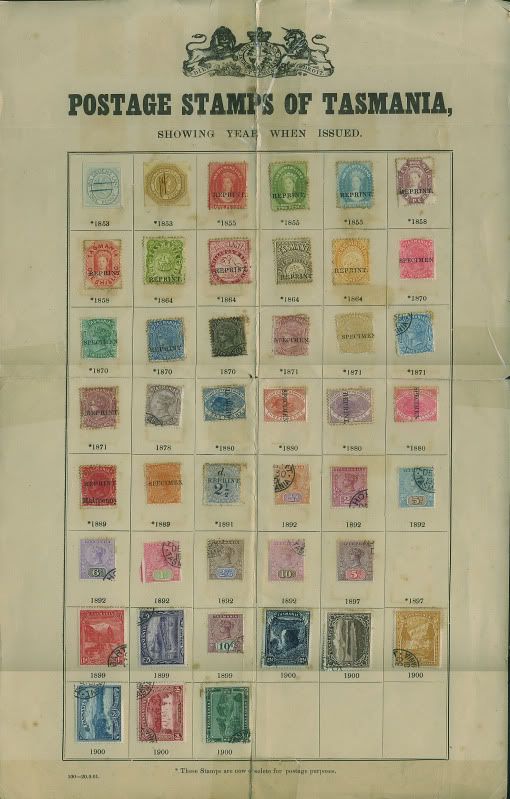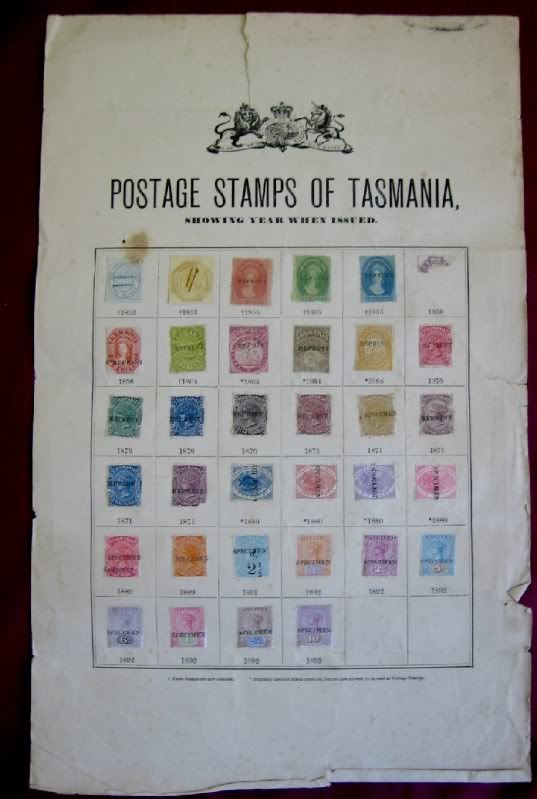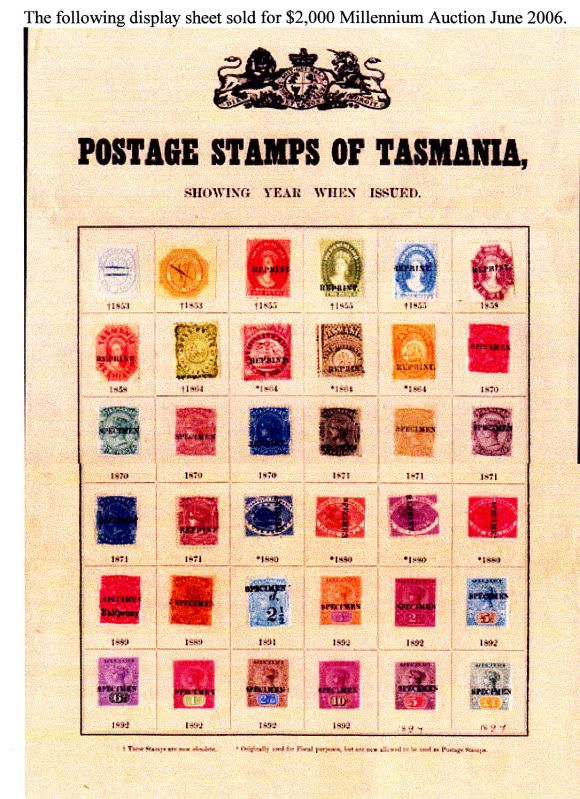Specimen display sheets
Specimen display sheets
The Tasmanian Post Office was in the habit of issuing specimen display
sheets showing the range of current issues. These sheets are discussed
in Chapter 16 of Tinsley's book (contributed by A.R. Butler).
These items are of great interest in themselves and also they throw some
light on what was currently available. In general, they showed a range of
Sideface, Chalon, Platypus, St George & Dragon and Keyplate issues, but
the details depend on the year of issue.
It would be of interest to illustrate a few examples on the BB and then to
estimate their approximate dates of issue.
Over to you.
sheets showing the range of current issues. These sheets are discussed
in Chapter 16 of Tinsley's book (contributed by A.R. Butler).
These items are of great interest in themselves and also they throw some
light on what was currently available. In general, they showed a range of
Sideface, Chalon, Platypus, St George & Dragon and Keyplate issues, but
the details depend on the year of issue.
It would be of interest to illustrate a few examples on the BB and then to
estimate their approximate dates of issue.
Over to you.
Re: Specimen display sheets
Don't know whether it's still in their collections somewhere, but I remember a specimen sheet being displayed in the Hobart Museum in the 1960's. Anyone got any contacts there?
Re: Specimen display sheets
I have these two pictures [not very good] of two sheets in the Bill McCredie exhibit "The Specimen Stamps of Tasmania 1861-1905 and their Protective Markings" Dave
Please visit my oz revenues web site: http://www.ozrevenues.com and don't forget "Illegitimi non carborundum"
-
Geoff Dane
- Posts: 77
- Joined: Thu Jul 16, 2009 8:40 pm
- Location: Bungendore, NSW
Re: Specimen display sheets
Below are a couple of scans of material from Auctions.
This 1 I noted sold for $550 through Status in 2008

and this 1 in 2009 through ?

and this 1 through auction in 2006 (sorry its a scan of a scan)

and there is 1 currently (March 2010) on the Prestige Auction.
Different layouts for different periods ?
This 1 I noted sold for $550 through Status in 2008

and this 1 in 2009 through ?

and this 1 through auction in 2006 (sorry its a scan of a scan)

and there is 1 currently (March 2010) on the Prestige Auction.
Different layouts for different periods ?
-
Ross Ewington
- Posts: 2079
- Joined: Wed Jun 10, 2009 5:00 pm
- Location: Hobart
- Contact:
Re: Specimen display sheets
jorija wrote:Don't know whether it's still in their collections somewhere, but I remember a specimen sheet
being displayed in the Hobart Museum in the 1960's. Anyone got any contacts there?
I may have an image of that item somewhere .... I'll see if I can track it down for posting in this topic. If I remember
correctly, it's not in a particularly "tip top" condition.
-
Ross Ewington
- Posts: 2079
- Joined: Wed Jun 10, 2009 5:00 pm
- Location: Hobart
- Contact:
Re: Specimen display sheets
The second sheet posted above by Geoff
[attachment=0]SpecimensheetTasAuctions2009.jpg[/attachment]
was sold by Tasmanian Stamp Auctions in June 2009 for $360 + charges.
It needed quite a bit of conservation work.
[attachment=0]SpecimensheetTasAuctions2009.jpg[/attachment]
was sold by Tasmanian Stamp Auctions in June 2009 for $360 + charges.
It needed quite a bit of conservation work.
- Attachments
-
- SpecimensheetTasAuctions2009.jpg (19.94 KiB) Viewed 4161 times
-
Ross Ewington
- Posts: 2079
- Joined: Wed Jun 10, 2009 5:00 pm
- Location: Hobart
- Contact:
Re: Specimen display sheets
This PRESENTATION SHEET from 1901 is being offered by PRESTIGE PHILATELY in their
EIGHTH RARITIES AUCTION to be held on April 10th, 2010.
It is estimated at AU$2000 but at the time of this post it was already starting at $2600 with
over two weeks still to go!!

The auction description and catalog may be visited using this link:
http://www.prestigephilately.com/cats.p ... ionnum=155
Sorry about the size anomaly in matching up the images but it's the best I could do in the available time.
EIGHTH RARITIES AUCTION to be held on April 10th, 2010.
It is estimated at AU$2000 but at the time of this post it was already starting at $2600 with
over two weeks still to go!!

The auction description and catalog may be visited using this link:
http://www.prestigephilately.com/cats.p ... ionnum=155
Sorry about the size anomaly in matching up the images but it's the best I could do in the available time.
Re: Specimen display sheets
In case the link to the auction expires, let me record that this sheet realized $4,200.
Re: Specimen display sheets
Sold in Grosvenor Nov 13 for 650 pounds plus buyers
Described in the catalogue as "Local Overprint" upon further requests for provenance i was told they "come from a receiving station in North Africa"
Described in the catalogue as "Local Overprint" upon further requests for provenance i was told they "come from a receiving station in North Africa"
Please visit my oz revenues web site: http://www.ozrevenues.com and don't forget "Illegitimi non carborundum"
Re: Specimen display sheets
This is a very interesting discovery from Dave.
Has the length and height of the unusual SPECIMEN handstamp on
some of these stamps been recorded, e.g. the first row of stamps?
As for their provenance, we are told that they come from a receiving
station in North Africa. This may be a receiving authority handstamp
applied by the postal administration of that country (unfortunately not
stated). Examples of receiving authority handstamps are discussed in
the recent book by Kellow, Turner and McCredie on Victorian specimen
stamps - and now we have examples for Tasmania.
Is there any way to identify the actual country or postal administration?
Comparison with previously known examples, possibly on stamps which
need not be of Tasmanian origin, may be helpful.
The other stamps shown in Dave's post appear to be of the well-known
types as listed in Butler's Chapter 16 in Tinsley's book. Two Pictorials
show both the handstamp and the usual type for London printings.
Further analysis and discussion would be warranted but this will have
wait for another posting!
Bill
Has the length and height of the unusual SPECIMEN handstamp on
some of these stamps been recorded, e.g. the first row of stamps?
As for their provenance, we are told that they come from a receiving
station in North Africa. This may be a receiving authority handstamp
applied by the postal administration of that country (unfortunately not
stated). Examples of receiving authority handstamps are discussed in
the recent book by Kellow, Turner and McCredie on Victorian specimen
stamps - and now we have examples for Tasmania.
Is there any way to identify the actual country or postal administration?
Comparison with previously known examples, possibly on stamps which
need not be of Tasmanian origin, may be helpful.
The other stamps shown in Dave's post appear to be of the well-known
types as listed in Butler's Chapter 16 in Tinsley's book. Two Pictorials
show both the handstamp and the usual type for London printings.
Further analysis and discussion would be warranted but this will have
wait for another posting!
Bill